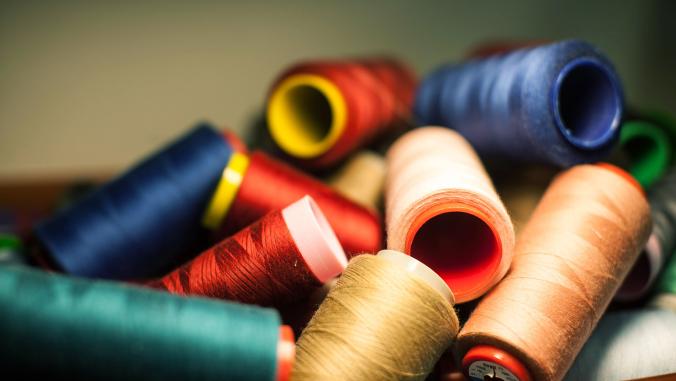How companies can embrace circularity in their material sourcing strategies
Incorporating recycled materials into product collections is a good start.

Customers lease Coyuchi products for as low as $5 per month and when they are done with the subscription term, they have the option to return the used items.
In conjunction with the release of the Textile Exchange 2019 Material Change Index, GreenBiz has partnered with Textile Exchange to publish actionable insights for apparel and textile companies looking to source raw materials more sustainably. The entire series may be found here.
Traditional business models in the fashion industry are inherently extractive. They are focused on producing in greater volumes over time, in a way that uses more resources and creates more waste.
In contrast, circular business models focus on retaining the value of existing materials through perpetual cycles. The Ellen MacArthur Foundation (EMF) defines a circular economy as one that designs out waste and pollution, keeps products and materials in use and regenerates natural systems. EMF argues that for the fashion industry to thrive, and not just survive, it needs to radically redesign its operating model and decouple financial success from natural resource consumption. A transition to a circular system has the potential to unlock an enormous economic opportunity for those brands willing to innovate and invest in new ways of doing business.
As an organization, Textile Exchange supports the apparel and textiles sector in switching to preferable materials that have a more positive impact on people and the environment compared to conventional. We find that leading companies that are committed to holistic improvement also have a circularity strategy in place. These strategies may address opportunities such as managing demand, designing products for disassembly or recyclability and providing services to extend a product’s life.
Incorporating recycled materials into product collections is a good start. Here, it is best practice to ensure that materials are traceable back to the source so there is a guarantee of the recycling process. Several "chain of custody" standards track recycled materials through the supply chain, including the Recycled Claim Standard (RCS), Global Recycled Standard (GRS) and SCS Recycled Content.
The next step for companies is to not only increase the use of recycled materials but to make sure their products and fabrics are designed and produced to be "recyclable." This involves rethinking blends between synthetic and natural fibers (which are difficult to separate); being mindful of how rivets, zippers and other accessories affect recyclability and watching the use of dyes and other wet processing chemicals to ensure materials can be recycled safely. If the industry is to become truly circular, materials must be able to have multiple life cycles.

How can companies level up their circular initiatives?
Every year, Textile Exchange publishes a Material Change Index that tracks the fashion industry’s progress toward more sustainable materials sourcing, as well as alignment with global efforts such as the United Nations Sustainable Development Goals and the transition to a circular economy. There are some key activities that top performers in the circularity category have in common. These should serve as inspiration for any companies looking to push their circularity initiatives to the next level. Textile Exchange also will be sharing a more detailed analysis of findings later in 2020.
1. Explore new business models
Circularity touches every part of the value chain and requires a systems-thinking approach. The brands with the strongest circular strategies are developing transformative business models that will help them be competitive in the future. These might include rental models, alternative markets for unsold goods, extended product responsibility and second-life business models. These new models likely will disrupt the way companies make money and so require buy-in and excitement at every level of the business.
Material change in action: Organic linens company Coyuchi launched its takeback and renewal program "Coyuchi for Life" in 2016. This program makes organic textiles more affordable, while taking back used products and creating a second life cycle for them.
Customers lease Coyuchi products for as low as $5 per month and when they are done with the subscription term, they have the option to return the used items. Returned items are sorted and cleaned, and then sold as "renewed" products under the brand 2ndHome.
The model is a natural extension of the brand’s ethos of building products that last, and about 80 percent of returned product has been fit for resale. The brand has found that customers are excited about the program.
"We were very pleased to see customer adoption almost immediately," said Coyuchi CEO Eileen Mockus. "The retention rate is higher than typical subscriptions and a majority of Coyuchi For Life customers would recommend it to others. It is exciting when customers come into our Point Reyes store asking for 2ndHome product as it keeps us motivated to renew more product."
2. Invest in innovation
As companies increase their uptake of recycled inputs and explore circular models, there is an urgent need to invest in new technologies that can close the loop efficiently and cost-effectively. In a circular model, there is no waste: All materials are viewed as a resource. A new circular textiles system will require solutions that enable us to recycle textiles back into textiles without degrading quality. Brands leading the charge in this area are investing in research and development and engaging in pre-collaborative initiatives such as Fashion for Good.
Material change in action: In 2015, German retailer Tchibo introduced a Closed Loop strategy that embraced three key aspects:
- Make: the use of recycled or responsibly sourced renewable materials;
- Use: facilitating a long lifetime of our products; and
- Recycle: ensure take-back and recycling
Based on these priorities, the company first initiated pilots that were relatively easy to implement within its existing supply chains and sales channels, such as increasing use of recycled plastics and communicating care, repair, upcycling and recycling options to consumers. In time, Tchibo extended these pilots to more innovative but also more complex initiatives, such as a partnership with FairWertung to take back used textiles and a rental model for children's clothes called Tchibo Share.
Pursuing these ideas required partnership, along with a fair amount of humility and willingness to learn.
"The topic is quite complex and we built up expertise while proceeding with the projects," said Nanda Bergstein, director of corporate responsibility at Tchibo. "We did not have all the answers at the beginning. But as we progressed, new opportunities and potential partnerships arose from which we could learn and grow even further. To me, this is one of the best side effects of working in sustainability."

3. Push the industry forward
Textile Exchange is an affiliate partner of the Ellen MacArthur Foundation’s Make Fashion Circular initiative, which brings together leaders from across the fashion industry, including brands, cities, philanthropists, NGOs and innovators.
The initiative's ambition is to work towards a "new textile economy" where clothes are made from safe and renewable materials, new business models increase their use and old clothes are turned into new. Leading companies use industry groups such as Make Fashion Circular to guide their circular sustainability strategies and identify opportunities to collaborate with other changemakers to drive the entire industry’s progress forward. They also share their learnings with others, treating the results of any internal innovation as an opportunity to lead industry transformation, not just a competitive advantage.
Material change in action: For years, Nike has been developing a pipeline of closed-loop and circular products designed with more sustainable materials. Inspired by the Global Fashion Agenda, the sports brand created an open-source framework for circular design with the goal of bringing as many designers into circular thinking as possible. Circularity: Guiding the Future of Designincludes guidance on product design innovation, best practices for re-imagining waste as a source of value and innovative ways to reclaim materials throughout the manufacturing process and at the end of a product’s lifecycle.
Nike used case studies in its guide to demonstrate how the principles in it can be adopted by brands of all sizes. It also partnered with students at the design school, Central Saint Martins, to make sure the guide resonated with the design leaders of tomorrow.
"Tackling this global challenge requires urgent action from everyone — big and small companies, governments, organizations and consumers," said Nike Chief Sustainability Officer Noel Kinder. "Advancing a more sustainable future requires that everyone adopt principles of circularity and with this guide, we are showing designers how they can make better choices today."





